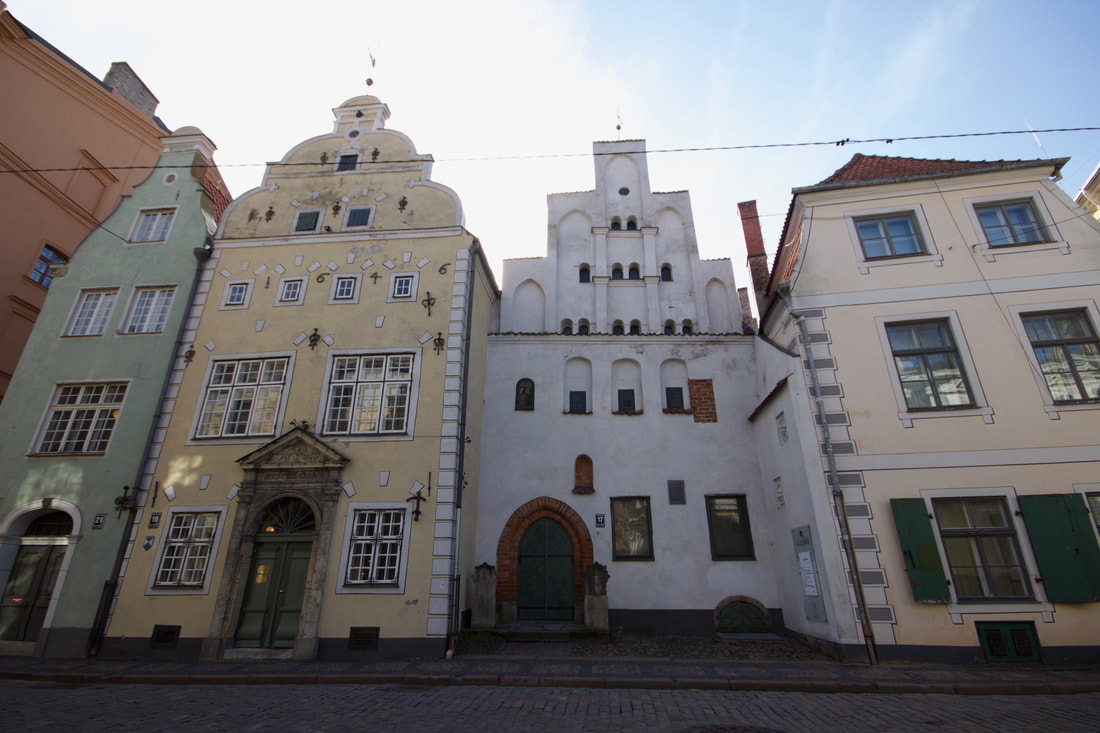Since its independence in 1991, Latvia is on the rise and today, one of the most precious cities in the Baltic. Be sure to explore these historical sites to learn more about Latvia and its ascension over centuries of struggle and hardship.
This 14th Century building originated as a guild for merchants and craftsmen who were joined by a brotherhood of banquet caterers called the Blackheads. Many Blackheads were German and banded together to protect their trading rights from robbers and pirates. Later, the brotherhood partnered with the patrician elite and rose into great power. Destroyed from a bomb raid in World War II, the House of Blackheads was rebuilt in 1999. Today, this former guild homes the President of Latvia.
The Three Brothers is a building complex that contains three buildings clustered together, which makes it appear almost as one structure. Legend has it that the buildings were constructed by three from one family. The oldest brother built in 1490 and was the place of manufacturing and trade. The structure is inspired by Dutch Renaissance. The middle brother built in 1646 features a Dutch Mannerism style and contains the inscription, "Soli deo gloria!" (“Glory to God alone!”) Built in the late 17th Century, the third brother is the most narrow and smallest of the three buildings and contains the Latvian Museum of Architecture, a worth-while visit for intellectual pursuits and to discover the back courtyard. These are the oldest medieval buildings in Riga, and where craftsmen once lived.
If you love World War II and Soviet history, visit the Museum of Occupation. Insides, visitors discover what Latvians have undergone between 1940-1991 under totalitarian regimes. From short films to real life relics, guests learn how many Latvians survived World War II by living in a forest and “taking down” the USSR with the largest protest, which included two million citizens linking hands across the Baltic. The chain linked the three Baltic capitals, Tallinn, Riga and Vilnius.
Built in 1920, this is one of the largest markets in Eastern Europe. Every day 80,000-100,000 visitors come to shop for meat, cheese, produce, desserts, household items or clothes. The market contains a mix of indoor and outdoor stalls. The large indoor hangers are actually made from 1920 zeppelins. For a traditional westerner, the market is cheap, but the prices are expensive or fair for the local’s income.
This statue towers over Old Town Riga in remembrance of the soldiers who died in the 1918-1920 Latvian War of Independence where Latvians overthrew the Russians. When Russia annexed Latvia in 1940, they nearly destroyed this monument, but saved by Soviets who believed in the importance of this landmark.
This unofficial symbol of Riga is a popular place for tourists to snap many pictures. The 1909 home contains two medieval turrets, both topped with black cats. The story is fuzzy, but these cats are symbols of a protest, or disgust, of one local man’s rejection to being accepted into the 14thCentury guild. Being part of the guild is a great honor whereas the guild rejecting someone is a massive insult. The man topped these towers with two hunched back black cats that glared at the guild. The upset guildsmen fought with the local for months. Eventually, the local turned the cat’s to glare elsewhere, but never took them down.
This 13th Century Gothic - Baroque church is not only a place of history and worship, but provides the best views in town. The 130 meter tower contains an observation deck at 72 meters overlooking old and new Riga. Five times per day a Latvian folk song plays from the tower. Outside the church one notices a statue of a donkey, a dog, a cat and a rooster standing on one another. This is the same statue one sees in Bremen, Germany and is inspired by the Grimm's brothers and to the Town of Musicians of Bremen to its Germanic roots.
Only a small portion of Riga's original city wall exists. The Swedish Gate was built in 1698 when Sweden took over the city. An interesting fact is that the apartment above Swedish Gate is where the city executioner once lived. The night before a beheading, he would place a red rose in his window.
Meandering around Old Town, visitors will notice intricate details in the facades of many buildings. Keep an eye out for dates and plaques that provide historical tidbits about each building.
What is your favorite landmark in Riga? Let us know!
This Lemon Tree article is now featured on GPSmyCity. To download this article for offline reading or travel directions to the attractions highlighted in this article, go to The Best Historical Sites in Riga, Latvia.















 RSS Feed
RSS Feed